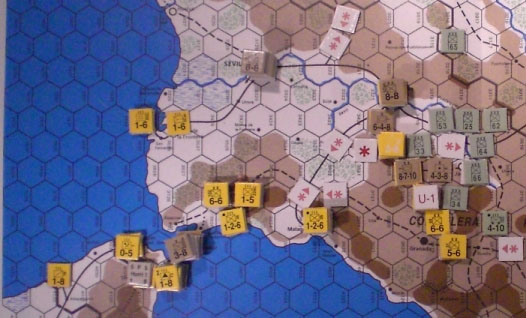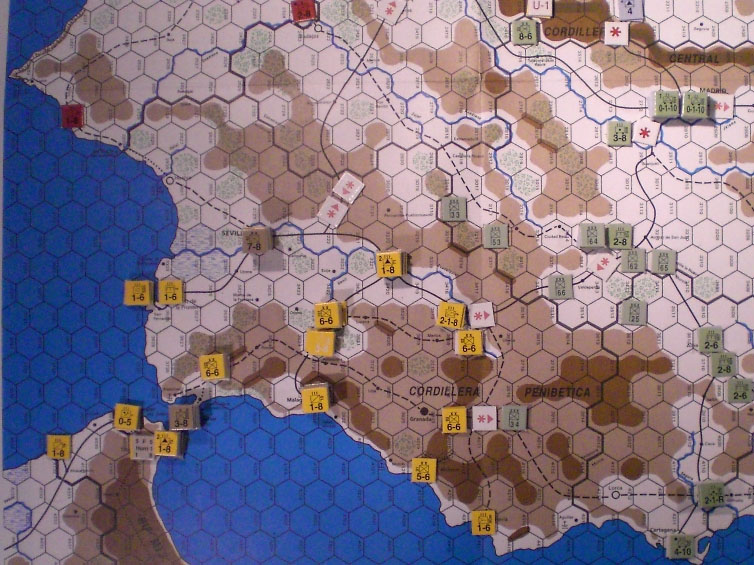Initial Phase: The Weather remains clear in Zones D and E, however the Sea is rough in the Atlantic and Mediterranean. All units are in supply, except for the Spanish 21st cadre in 23A:2315. It remains at U-2. Spain generates 3 GSPs in Sevilla.
A new air cycle has begun; the Germans receive 10 ARPs but have no aircraft to bring back this turn. Germany also receives 6 Infantry RPs (total 13) and 3 more Arm RPs (total 14). They bring back the only two units in the replacement pool, the 402nd Bicycle battalion and the 616th Motorised AT battalion (1.5 Inf RPs/0.5 Arm RPs spent). The two-wheelers appear at Caceres while the AT unit is formed in Leon. 3 Me109Es fly CAP over Jaen from 3213.
Movement Phase: Near Valencia in 3705, the 263rd Infantry division breaks down into its supported components in order to garrison captured Mediterranean ports. In order to assault the Allied line, forward airbases are required for the German fighters and dive bombers.
The 674th Combat engineer starts the ball rolling by combining with the 7th Construction engineer to build a temporary field in 3212. It then moves to 3313, and is joined there by the 667th Combat engineer which uses rail and ground movement to reach the hex. Together these two units construct a second temporary airfield. Another airfield is built in 3312 by the 604th Combat engineer regiment which rails in before beginning construction. Finally, a temporary airfield is set up next at Alcazar de San Juan by the joint efforts of the 519th Combat Engineers and the 16th Construction Engineers, which both use rail movement to reach the target.
Three engineer units are further back from the front. The 71st Construction regiment moves to capture Alicante, which will allow one of the regiments of the 263rd division to admin move to the city. The 71st then heads one hex west to Elche. The 512th Combat Engineer regiment uses admin movement all the way up to Ciudad Real. Last but not least, the 108th Construction regiment administratively moves from Valencia to 3410.
The regiments of the 263rd Infantry disperse. One moves to Alicante, a second takes over duty in Cartagena, while the third heads back east towards Tarragona, although it can only reach as far as Reuss in 3529. In the relatively quiet Galicia province, the Germans have dispatched elite mountain troops to break through the Spanish defenses. The 15th Corps moves from 1509 to 1012, while the 616th Motorised AT battalion moves up to 1113 to join elements of the 11th Infantry division there.
Near Madrid, the final 4 points of position AA sent to protect the city facilities arrive via ground movement, 2 points going into each hex. Close by, the 608th Motorised Artillery regiment leaves Toledo and heads south to Valdapenas.
In the west, the 402nd Bicycle battalion moves from Caceres to Badajoz, where it gazes over te border at the Portuguese 1st Cavalry brigade. Rail regauging is conducted by the 4th RR Engineer regiment, which advances the southern railhead to 3529 before moving to 3530. The northern railhead is left alone by the 1st RR Engineers, they instead move to 2412. From Cartagena, the GD Motorised division heads down the coast to 4416, and prepares to seize the lightly defended port of Almeira.
The 33rd Corps thrusts around the main defensive line between Cordoba and 3418 to cross the river and reach 3419. The 53 Corps moves up in front of the Spanish positions to 3318, while the pincer is completed by the 25th Corps which brings its tanks up to 3417. The other end of the Allied line is also to be attacked. The 34th Corps pushes its armour into the mountains at 3717, the 66th Corps moves to its start line at Ubada, while the 64th Corps heads to Linares. To bolster the attack, the 603rd and 609th Artillery regiments are detached from the 62nd Corps and sent to the 66th. Similarly, the 783rd Artillery regiment in the 65th Corps is ordered to join the 62nd for the attack.
A follow-up echelon consisting of the 62nd and 65th Corps is sent forward behind the main assault. The 65th Corps uses admin movement to enter the wooded rough of 3118, and the 62nd is sent to 3416.
Combat Phase: There are no German fighters in interception range of 3418, so 2 Whitleys and a Blen 4 fly unescorted DS to the hex. The Blenheims are assigned to targets heavily protected by the flak guns of the 25th and 33rd Corps, and they are aborted. The Whitleys avoid the flak and deliver 1 effective point of DS.
To the south, 3 German Messerschmitts are flying CAP over 3617 (Jaen). A Spitfire, a Hurricane, and a Spanish Me109 stage through Granada in order to fly escort for a GS mission made up of SM79s, British A-22s and Blen 4s. The Germans switch to interception and one unit tries to bypass the screen. It is taken on by the Hurricanes, which roll up an abort. The other two Me109s attack the Allied escorts, managing to shoot down the Spanish Me109s and abort the Spitfires, while suffering only one R result themselves. The AA guns of the German 34th Corps go into action and bring down a lot of low flying A-22s, aborting them. The other two bombers get through unscathed, to deliver 1 point of effective DS.
The Germans fly a GS mission against both Jaen and 3418. Since the British have cleverly kept fighters in reserve in Cordoba, the Germans must escort each mission with only 3 fighters. All short range aircraft stage through the various airbases that have been built in front of the Allied positions. Against Jaen, a Me110C, a Me109E and a Me109F escort 2 He111s and 2 Ju88As. Hex 3418 is subjected to a larger attack, with 5 Ju87Bs and 2 He111s zeroing in on the defenders escorted by 2 Me110Cs and a Me109F.
The Allied fighters intercept the northern mission over 3418. A Hurricane and a Spitfire attempt to bypass the screen, while Spanish I-16/t10s engage the escorting fighters. The I-16s are allocated against Me110C4s, but both aircraft miss each other. A Me109F returns the Hurricanes but the Spitfires get past German Me110C1s, and manage to shoot down a He111, at no loss. There is no Spanish AA, so 22 points still make it to the target zone. Since there is also no AA in Jaen, all the bombers drop their munitions there unhindered. 10 points of GS will be added to the attack.
Jaen is under attack from 3 sides. The German 64th and 66th Corps are pumped up with artillery since they are attacking over the river. However, the 34th Corps which has ploughed through mountainous terrain is at full strength. Due to the rough terrain and fort in the hex there is a -2 on the roll. Together the 3 German Corps are worth 66, plus 10 GS for a total of 76. The defenders, mainly composed of the 23rd and 92nd Infantry divisions, have a printed strength of 13, plus one point of DS for a 14 total. This equates to 5:1 -2. 4 comes up, modified to a 2 for a DR. The Allied units retreat in good order to Martos, and the 66th Corps advances over the river.
3418 is held by the Spanish 101st Infantry division, backed up by numerous good quality infantry and artillery units. With 1 point of support from the Whitleys overheads, the defensive total is 17. Ranged against them are the German 33rd, 53rd and 25th Corps. The 33rd Corps is at the rear, compromising the defenders. Numerous German armoured assets are taking part in the operation, and despite the 3 Infantry divisions of the 53rd Corps there is still enough AECA for a +2 on the roll. The river reduces the effectiveness of the 53rd and 35th Corps, such that the attackers have a total of 52. However, Stukas and a few Heinkels pour from the sky in a never ending stream, adding 22 for a total of 74. This gives a 4:1 +2 ratio. Another 4 comes up, modified to a 6 for a DE. Due to ZOCs, all the Spanish are eliminated (but were not isolated). The 53rd Corps advances over the river.
Near Madrid, the shattered remnants of the 21st division are attacked by the 22nd Air Landing and 5th Infantry divisions. Since the Spanish are at U-2, they are halved, and only worth one. The mountains mean that the Germans are also halved but the attack is still 8:1 -2. 6 comes up, still a DE after the modification to 4. The Spanish are eliminated, and the Germans do not advance. On the Mediterranean coast, the GS Motorised regiment attacks the port of ALmeria, which is held by the 3Car Border regiment. The border guards are unsupported, and only worth 0.5, while the Germans are supported and are worth 4. Rough terrain provides a -1 to the 8:1 attack. Although a 2 is rolled, its still good enough for a DH, and the Germans take the town.
The final attack is in Galicia, with the German 15th Mountain Corps attacking 1013, backed up by 2 regiments of the 11th Infantry division. The Spanish are worth 5 while the Germans can muster a total of 20, giving a 4:1 -2 assault. The die shows 5, modified to 3 for a DR. The Spanish retreat to 1014, and the 15th Mountain Corps advances. The pass through the mountains has now been secured.
All the German short range aircraft land at their forward airbases, while the long range units land in Murcia and Madrid. Allied air units return to base in Sevilla, Cordoba and Malaga.
Exploitation Phase: The 34th Corps continues to work through the mountains and moves into 3718. Behind it, the GD Motorised regiment and 608th Artillery regiment take up a position in 3816, where they will screen the southern flank of the German advance. The 33rd Corps tightens the noose on the Allies, moving from 3419 to 3519.
Losses
- Spanish Unisolated – 16+2 (3.5 Special RPs received)
- Spanish Isolated – 0
- Spanish Air 1K
- German Unisolated – 0
- German Isolated – 0
- German Air – 1A/1K
- British Unisolated – 0
- British Isolated – 0
- British Air 3A

